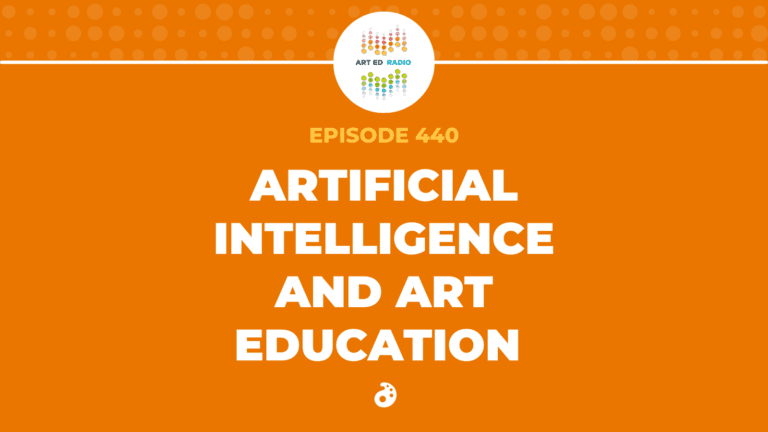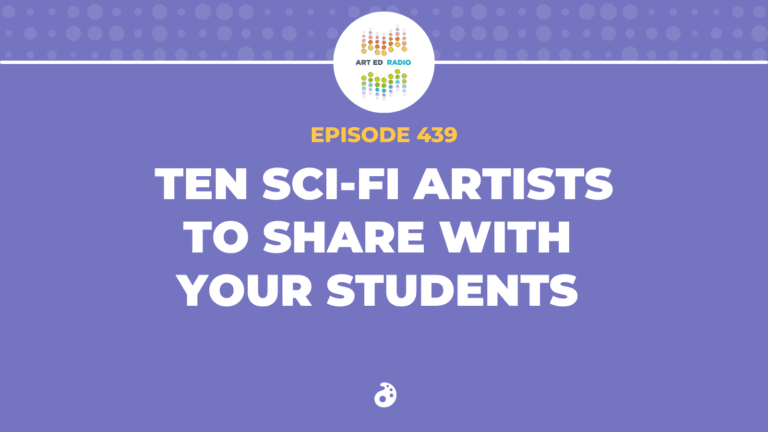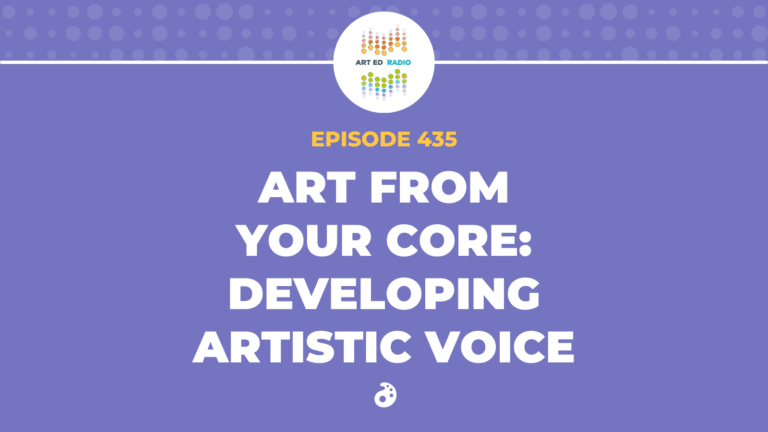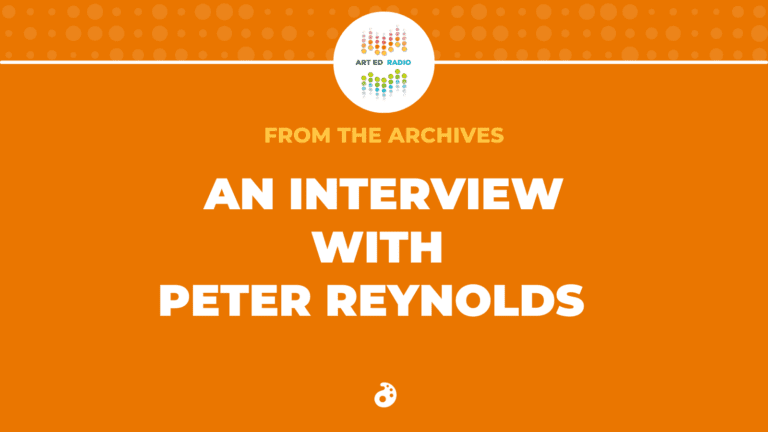With Hour of Code happening this week, it is time to explore some of the connections between coding and art. In today’s episode, author Valerie Sousa and illustrator Jen Leban join Tim to discuss their book Coding to Kindness. Listen as they talk about the parallels with art and coding, the different ways we teach skills, and the importance of kindness for all of our students. Full Episode Transcript Below.
Resources and Links
- View Valerie’s author website
- Find Coding to Kindness for sale here and here, and the publisher here
- Follow Jen on Twitter and view her Coding to Kindness read-aloud
- Hour of Code
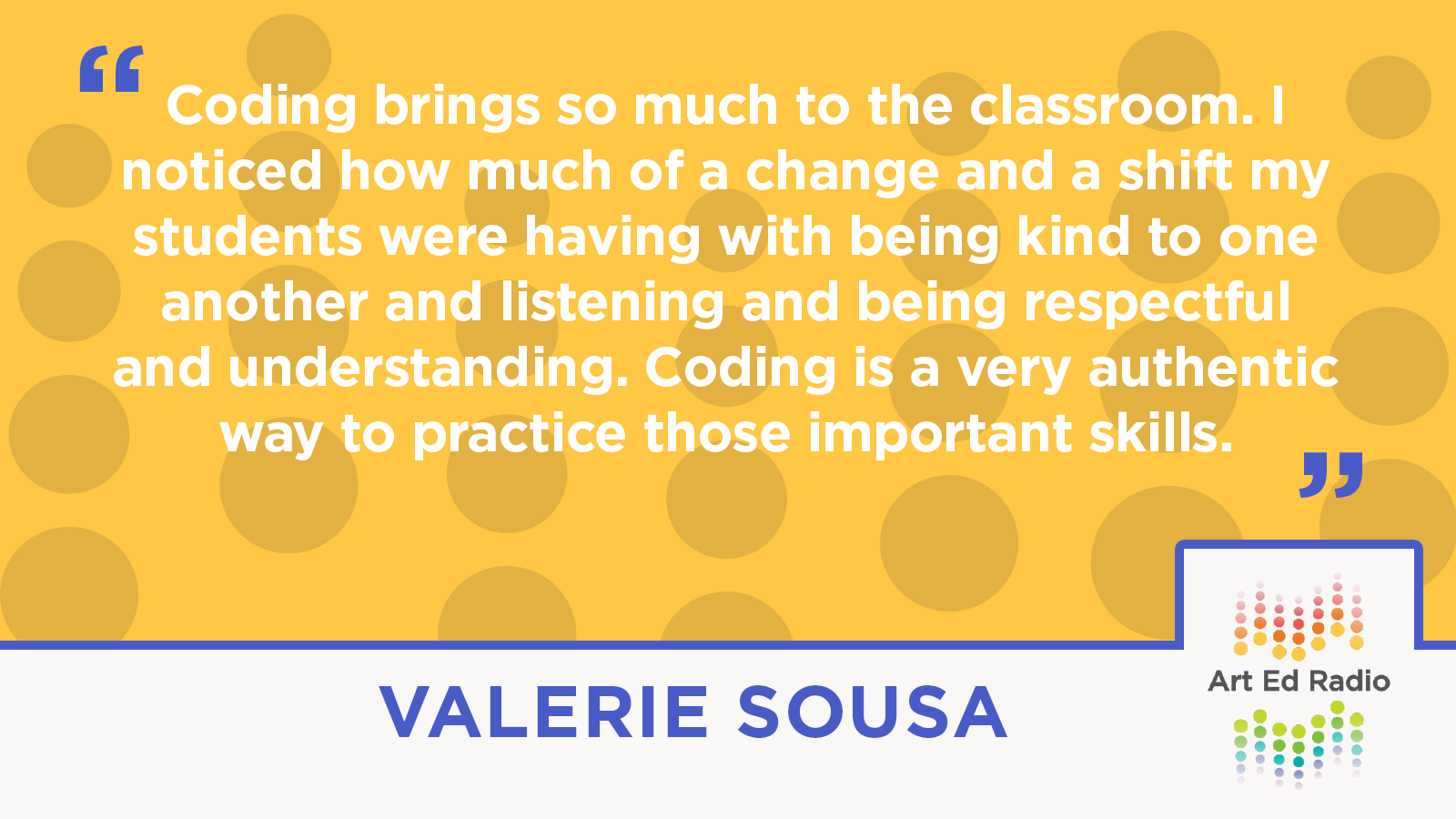
Transcript
Tim: Welcome to Art Ed Radio, the podcast for art teachers. This show is produced by The Art of Education University and I’m your host, Tim Bogatz.
As you may or may not know, this week is Hour of Code. Now, the Hour of Code started as a one-hour introduction to computer science, kind of trying to de-mystify the idea of coding to show that anybody can learn the basics, and just kind of getting more kids interested in computer science. And it starts with one hour coding activities, but it can expand to so much more, and there are so many connections between art and coding, art and computer science, and I know that a lot of art teachers are looking for ways to take part in Hour of Code. So, I wanted to talk today about coding and luckily we have a great connection. Our friend Jenn Leban, who has been on the show and at the NOW conference before, actually illustrated a book that came out this fall called Coding To Kindness, and she is here today along with the author of the book, Valerie Sousa, who is a kindergarten teacher who uses coding in her classroom to help develop so many skills with her students.
Now, Coding To Kindness is a great book about coding, but it’s also about friendship and social and emotional learning and it has great illustrations and fantastic puzzles and it can serve as a wonderful introduction to so many topics in the classroom. So, we’re going to talk about all of those things and maybe a little bit about what it’s like to write a book and illustrate a book with Valerie and Jenn, a couple of amazing teachers. Let me bring them on now.
All right. I am here with Valerie Sousa and Jenn Leban. Hello to both of you. How are you, Valerie?
Valerie: Hello. I’m great and thank you for having me.
Tim: Yeah. We are excited to chat with you. Jenn, welcome back. How are you?
Jen: Yeah. I’m good.
Tim: Good. Glad to hear it. I guess to begin, can we just have both of you introduce yourselves so everybody knows who we’re talking to? Jenn, you’ve been on the show before, so you get to go first.
Jen: Woo hoo. All right. So, my name is Jenn Leban. I am originally an art teacher. That’s what I went to school for. So, I taught art for 13 years at the middle school level, then I taught tech for a while and this year I started a new adventure at elementary and I am a K-5 library media specialist, so I also teach STEM and makerspace curriculum. So, it’s kind of this hybrid of all those things that I love, the tech and the making and the being creative and the art stuff. Yeah. And then, newest adventure is I can also add children’s book illustrator to that bio there.
Tim: Very nice. Very nice. Valerie?
Valerie: Yes. Hi. So, I am a kindergarten teacher. I’ve been a kindergarten teacher for over a decade now, a little over a decade, and I started a few years ago coding in the classroom and integrating a lot of that into my kindergarten classroom, and I loved it so much and it’s sort of where the inspiration for Coding To Kindness came along and connected me with Jenn. And then, here we are today.
Tim: Perfect. And gives me a perfect segue. I wanted to ask about your book, so Valerie, can you just tell us a little bit about the book? What it is, the inspiration behind it and what kind of made you want to write the book in the first place?
Valerie: Mm-hmm (affirmative)-
So, I did start coding in the classroom about four… Three or four years ago. I don’t know. This year’s been a blur, so…
Tim: Yes.
Valerie: We can give or take a year. It’s been a year.
Tim: For all of us. For all of us.
Valerie: So, I… I was kind of looking at it more from the academic light, where I was hoping to get mathematical skills and computational thinking and really get them thinking about all that, but then so much more was just handed in a nice, beautiful silver platter to me because coding brings so much more than just that. It brings so many more things to the classroom, so I really started to notice how much of a change and a shift my students were having with being kind to one another and listening and being respectful and understanding everyone has different paths to get there and being patient. All those really important solid skills that need to be taught in kindergarten started just coming alive and it was a very authentic way to practice those skills, which was really important.
So, I started thinking about it and I really wanted to write a book about coding because I loved what it brought to the classroom, but then I also wanted to incorporate that kindness piece. So, the book is also near and dear to my heart because I chose three characters that are near and dear to me. They’re amazing women in computer science, so there’s Ada Lovelace, Grace Hopper and Dorothy Vaughan.
Tim: Mm-hmm (affirmative)-
Valerie: And they are wonderful pioneers of computer science, and there’s a little bio in the book as well as information on the website, too, about them. But it just gives kids an opportunity at an early age to just dive into coding and at a very basic level. It’s not any binary coding going on. But it’s… It’s a really cool process because it’s just like we need to learn our ABC’s and 123’s and that turns into sentences and then picture books and novels and so on, and it builds, and we need to start somewhere and I think it’s really cool that we can start in a K-2 setting.
Tim: Yeah, absolutely. I think that’s a really novel, a really unique approach, which I think is really cool. Now Jenn, let’s chat about the newest line on your resume, children’s book illustrator. How did you originally connect with Valerie to illustrate this book and what made you want to work on it? What drew you to the idea?
Jen: Well, clearly, with my arts background, art is something I enjoy doing. Art is my… I guess it’s… It’s the driving force behind my life’s work and I think all the art teachers can relate to that. We just have this drive to create.
Tim: Yeah.
Jen: So, I’m a constant doodler, way into sketch-noting and things like that. Hipster sketch-noter before it was cool and… So, I had been putting some of my little doodles online. I actually work with… I don’t know if you’re familiar with SlidesMania, but I did… She does slides themes for PowerPoint and Google Slides.
Tim: Mm-hmm (affirmative)-
Jen: So, I did a theme with her, just through interacting on Twitter and stuff, and I had really had fun with that and I kind of put out into the world like, “Hey, I’d like to illustrate a book someday.” And a lot of my education friends are doing those teacher books and things.
So, I actually have a friend… Like friend through friends through friends, how it works, all of the networking, that runs EduMatch Publishing, and I had sent her some of my work, like just kind of a portfolio, just my little cartoon-y sketches.
Tim: Yeah.
Jen: So, nothing super-formal and cutesy. And Valerie actually picked me from my little portfolio, so… So, it’s super… Super-cool and sweet. But it worked out well because not only do I have the art background but the kind of coding and tech and girls in STEM motivation as well. So, it was just like the project was the perfect thing, so when I got asked to do it, I was like, how can I not? This is amazing. So, yeah.
Tim: Yeah. Absolutely. That’s everything you love wrapped up in one, so that’s perfect.
Jen: Pretty much.
Tim: So… And then, Jenn, can you talk a little bit about your illustration style? I mean, you had mentioned the portfolio, but are these drawings or these illustrations similar to what you always create or did you push yourself and do something differently for this book?
Jen: That’s… Yeah. That’s such an interesting question because I don’t know if I ever felt like I had style except that when I was in college, I had a professor tell me once that my art was feminine, meaning kind of cutesy. It had a soft edge to it.
Tim: Yeah.
Jen: And I… That always kind of stuck with me because I took it as a negative and I was like, “Oh, I’m not edgy enough and I’m not… I can’t make it in the art world.” And I always kind of had that with me. So, when I was thinking about this book, I actually didn’t have to be afraid of that because it’s a book for early primary with females.
And I’m like, “Well, I guess my style lends itself really well to that.” I mean… And as you know, you just sort of embrace… Like, you are what you are, you know what I mean? So, if my work’s feminine, well, so deal with it. That’s how I draw. Whatever. So, a lot of that self-consciousness has kind of gone by the wayside the older that I get, so it’s just not, I guess, a concern as much. But that’s something that I always think about. So, when I started drawing this, I actually did the whole thing on my iPad. It’s all done digitally.
Tim: Nice.
Jen: With my Apple Pencil and Procreate, my favorite thing. I saved all my initial drawings and sketches for it because when I originally drew the characters, they just… As a result of my style, they looked older, and when Valerie came back to me and she was like, “No, they got to be younger.” Like… I don’t know. What age would you say, Valerie, the girls are? They’re definitely younger.
Valerie: I was just envisioning kindergarten to two.
Jen: Yeah.
Valerie: And your drawings showed older girls.
Jen: Yeah.
Valerie: It just looked like those girls were more upper elementary, maybe early middle school.
Jen: And I don’t know if maybe it was because I was teaching that level, that was just what came to me. So, it was funny because when you said they needed to be younger, I was like, “Yeah, that makes sense.” But then all of a sudden, I had this conflict where I was like, “How do I make them look younger?”, So, I was like, “How do I do that?”. So, I looked online and I looked at the work of some other illustrators and things and there were some things I realized, like… This is going to sound weird, but making the eyes bigger and kind of rounding the faces a little bit more. Something about that kind of worked to make them look younger for my particular style of drawing. That was something that worked. So, I did have to kind of experiment with the concept a few different times to get… To get it to look the way I wanted it to. But once I… Once I figured it out, it’s not like it was hard. It felt right. It wasn’t like I was working against anything, so… Yeah.
Tim: Yeah. Nice. So, just a little bit of trial and error, but you got where you needed to go.
Jen: Yeah.
Tim: So… Cool. All right. Now Valerie, I wanted to circle back around to something that you had mentioned earlier, just doing coding with kindergarteners, with kids who are so young. I think people are kind of fascinated by that because I don’t think a lot of teachers do that. So, can you talk a little bit more about how you use coding in your own classroom and also how some of those ideas translate into the book?
Valerie: Absolutely. So, this year I have been remote since August, so I have to say and be honest that coding has not been something that I’ve done a lot of this school year.
Tim: Yeah.
Valerie: Just because it’s very difficult with remote and beginning of the year kindergartners and it’s just… It’s… It’s been a year. But before that, when we were in the classroom… And I’m so excited to get back into it… We did so many different activities and a lot of them were either… Sometimes they were using tech, like ScratchJr’s a great program.
Tim: Mm-hmm (affirmative)-
Valerie: And Kodable. There’s code.org activities. There’s a lot of things that are on the iPads that they can use, and we are fortunate to have iPads in the classroom. But there was so many things that I did that were offscreen, and I think that that’s as equally as important, if not more important, in the earlier grades to really get an understanding from offscreen tasks. So, a lot of it is a grid, so it’s just a grid formation and there’s actually opportunities in the book. So, it’s really cool because the book is very interactive. So, in order to get the girls back to kindness, you have to literally code on the grid and avoid those bugs. So, there’s bugs… And that was a final art edit in there. It was the last… Probably one of the last details. I was like, “We need to add little bugs because it’s just… It makes sense.”
Jen: It needed it, though. Like, we didn’t…
Valerie: Yeah. So, she came back with these really cute little bugs in there and it just added a whole nother layer to the idea of coding and that we have bugs in friendships and we have bugs in coding.
Jen: Right.
Valerie: And we want to avoid them as best as we can. So, yeah. It was just… I do so many different activities. For example, I get little clues about all the kids. This is more of an icebreaker type of thing at the beginning of the year. I get clues about the kids, I write them down and then they each have their name, so they’re learning how to recognize their name, write their name and learning other kids’ names.
Tim: Mm-hmm (affirmative)-
Valerie: And that’s a huge part of the beginning of kindergarten. So, I would say, “Jenn loves Halloween” and the other kids have to realize… Or, I would say, “Who loves Halloween?”. Not “Jenn loves Halloween.” I would say, “Who loves Halloween?”. And then they would have to code. We have… It’s not a [inaudible 00:14:29], but it’s similar. It’s a mouse. So, they’d have to code through the grid on the table to the child who they think it is. And so, it’s fun. It’s exciting. But it’s also getting to know each other. And that’s just one example. We use our rug. I have a rug that’s actually squares, which worked out perfect. It wasn’t really on purpose, but it was a beautiful thing that I noticed, so we use Dash, the robot there.
And then we code to different things as well. We use learning resources. There’s The Mouse and On The Grid and there’s different puzzles that they have to get through and they work together and it’s just… It’s so cool to see because they really struggle and it’s productive struggle and that’s so important and… But they don’t give up and they really, really keep going and our motto at our school is “Hand in hand with kindness we can dream, persevere and grow.” And we say it every day, so they hear that word “persevere” and they know what it means.
And they… I remember one time walking over and a child was like, “Don’t worry, Mrs. Sousa. We’re persevering.” And it’s just… It’s so cool to see it firsthand that it’s hard and they were struggling but they did not give up and… So, I do many different types coding. Those are a few. I use the Ozobots, too, in the classroom, which they love. There’s a lot of different resources out there. But the biggest thing is the grid and thinking of that and thinking of a start and an end and some bugs and things getting in the way and how are we going to get from one point to another, and we’re going to sequence those cards and learn directionality. They learn mathematical thinking. They learn how to agree and disagree. I mean, just so many skills.
One other thing that’s my favorite… Sorry. I’m going to add more and I feel like I’m talking too much!
Tim: No, no, go ahead. I love all of this.
Valerie: So, in social studies, one of the standards is learning about our community and what makes a great community. So, we talked about it. We made a list. We made a whole chart of, “We need a library. We need a town hall. We need the fire department, the police department. We need a school.” And they even added a Home Goods in there.
Jen: Need.
Valerie: And I was like, “Yeah, that makes sense.” But then we put it on a grid, on a big piece of paper. I drew out a grid and then I let them draw those places, so they drew the fire station, this and that. And then they had to code through our town.
Tim: Oh, man.
Valerie: And it was really cool because they learned about our town and all the things that are in it and they were drawing pictures of even local stores and things like that and different places and they were able to practice coding, but also learn a social studies lesson as well. So, it just lends itself so nicely to every subject that it becomes a very multidisciplinary approach, which is wonderful.
Tim: Yeah. That’s perfect. Now Jen, I wanted to ask you, just kind of along the same vein… Valerie talked about so many different ideas there. You have a little more experience with some older kids, so I’m just curious. Do you use similar programs when you’re getting kids started, when you’re doing things? Or are there different things that you think work better for older kids?
Jen: Well, it’s interesting because as I move down to the lower levels, it’s been very eye-opening for me what coding means in one place versus another place. So, in the middle school, when we studied coding, it was much more literal. We were using drag-and-drop block coding with things like Scratch and they were learning this is what a function is and what a variable is, but in more traditional terms. And then in eighth grade, they would actually do some text-based coding.
So, it’s funny because you would think, “Oh, coding at kindergarten level.” You’re like, “How does that even?”
Tim: Yeah. Yeah.
Jen: And to an outside person to watch it, they would see code… They wouldn’t even recognize it as coding, that what we’re doing is coding. We’re literally just giving directions, is what… It’s giving directions and following directions and there’s a lot of concepts in coding, like today in kindergarten we did patterns. What is a pattern? How does a pattern work? I mean, we were straight up doing art and… But then, we talk about how a computer programmer needs to be able to create patterns that repeat too in order to perform the directions or the skills he wants to do. So, it’s interesting because the concepts are still the same at middle school level. We did… We talked about functions in terms of dance. So, if you know the… What’s it? The Cupid Shuffle? To the left, to the left, to the right, to the right.
Tim: Yeah. Yeah [laughter].
Jen: So, we talked about how you would write that all out and you would go to the left four times and to the right four times and then you would kick twice and then you would… And that whole thing, you would loop it and repeat it. So, we wrote a program for the Cupid Shuffle, you know? So, it’s just kind of tying those things into more familiar terms. That works at all levels. But… But, yeah. It’s… It was interesting to me. So, coding, how this book explains it, is not coding the way kids are writing programs and making James at a middle school level. But it is absolutely all tied together and the concepts are the same so that when they see it at middle school, they’re like, “Oh, yeah.” It’s a pattern. It’s a loop. It’s something that repeats. So, those kinds of core concepts, they remain constant.
Tim: Perfect. That makes a lot of sense, so thank you. And then Valerie, just real quick before we wrap things up. Can you tell everybody where they can find your website, where they can order your book, all that good stuff?
Valerie: Yeah. So, the website is www.valeriesousaauthor.com and there’s information about me and Jenn, and there’s extra resources on there as well. So, there’s many resources that… Some Jenn created and some I created. There’s digital and ones that you can print for both styles of learning in 2020.
The book is available on Amazon and it’s also available at Barnes and Noble, and if you get bulk orders, which are more than 10, you can order right from edumatchpublishing.com.
Tim: All right. That’s perfect. We’ll make sure we link to all of those in the show notes so everybody can find that. Valerie, Jenn, thank you both so much. It’s been great talking to you.
Valerie: Thank you.
Jen: Thank you for having us.
Tim: All right. I really enjoyed that conversation. I loved hearing from Valerie about how she takes what she’s doing in the classroom and connects it into the book that she authored, and I also appreciated how passionate she is about what she teaches and how many great ideas she wanted to share. I also loved talking to Jenn, obviously. She’s been on the show before. She’s wonderful. But it was cool to hear about her artwork submission process, what it was like to illustrate the book and just kind of hear how that process works. But if you’re interested in Hour of Code, this book is a great place to get started with that. We’ll put all of the relevant links in the show notes so you can find the book, you can find Valerie’s website, you can find Jenn on social media. She shares so much. She is so helpful there. And Jenn even has an awesome read-aloud of Coding To Kindness on YouTube that you can use in your classroom. It is a great place to start with coding. And I hope Valerie and Jenn have inspired you to do just that.
Art Ed Radio is produced by The Art of Education University with audio engineering by Michael Crocker. Thank you for listening and I will tell you that we have a very cool artist coming on next week that I cannot wait to introduce you to, so I hope you will give it a listen then.
Magazine articles and podcasts are opinions of professional education contributors and do not necessarily represent the position of the Art of Education University (AOEU) or its academic offerings. Contributors use terms in the way they are most often talked about in the scope of their educational experiences.
